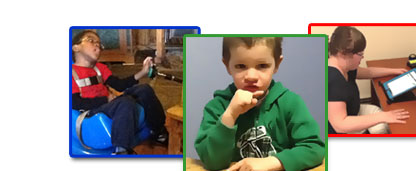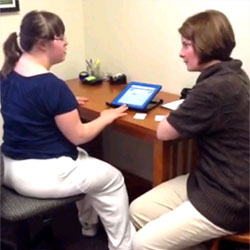| Welcome To Simplified Speech Solutions, LLC Bonnie Vaillancourt, M.S. CCC-SLP 148 Key Road, Suite B Keene, NH 03431 P: 603-352-4199 F: 603-352-9177 |
Today is |
Coordinated Care |
What is truly unique, though, is that when one session ends, children seeing one therapist may bound down the hall and start a new session with another one of these women. Vaillancourt’s client might move to French and now be able to tell her on his own that eating is his most important goal, while Vaillancourt joins Greenwood in the gym to co-treat a patient by using physical therapy techniques to help with pronunciation and speech therapy. Having all three services together under one roof is truly a boon for parents whose child with special needs requires more than one service. Not only can parents stack their sessions to optimize time away from home and minimize running to and from appointments, but together the three independent therapists can coordinate care and work in conjunction with each other to make sure each child is moving steadily and efficiently toward their goals. However, for parents not able to come to Keene to work with Greenwood, French and Vaillancourt, or unable to find a facility in their area that offers similar synchronized care in one office, parents can still create and execute their own integrated therapy plan that avoids each provider setting individual objectives and moving at a pace without regard to a child’s work and needs in other treatment areas. “There is an increased functionality of overall programming working to a common goal,” Vaillancourt said in regards to the advantages of working together in a team setting. “For me, kids can use their voice in a functional way between communication partners.” As Vaillancourt points out, coordinating care between all members of a child’s team offers a wide variety of benefits that can boost a child toward achieving his personal goals at a much faster rate and with improved efficiency among everyone who works with the child.
French echoed this thought saying, “Coordinating care really helps look at the whole kid. It deepens the bag of tricks we can use as I’m not tied to just my experience. It can really deepen and make sessions more powerful.” Part of this mindset of depth of care refers to seeing where the child might be struggling and using another’s expertise to supplement and help guide them forward. For example, at occupational therapy a child with a limited range of motion may be just short of being able to reach where they need to in order to dress themselves. Knowing this, the child’s physical therapist can look to increase strength and flexibility in the body areas essential to making that last stretch to fulfill the OT goal. In another instance, children unengaged or hesitant in PT and OT sessions may need assistance from speech therapy or even a counselor to express themselves and let adults know they are bored or uncomfortable or simply want to work on something else. Parents can help their child by facilitating an integrated care plan involving multiple members of their child’s care team. The first and most critical step in putting this type of network together is to first inquire about the willingness of individual providers to undertake the extra time and effort needed to corroborate. “First we need signed releases to share information. Then parents can ask how often do the individual practitioners meet and how can the channels of communications be opened up between school, church, family, medical staff and more,” French said. “Parents should also find out what is the best way to communicate,” Greenwood said. “For us here, email is best. ‘Would you be willing to do a team meeting where we all sit down together?’ is another question parents can ask.” In most cases, a dominant part of the child’s day is his time at school. The therapists and teachers on staff will direct a large part of their daily work both academically and in meeting special needs. Since the school setting plays such a large role in a child’s life, having this faction on board with an overall therapy plan that goes beyond meeting educational needs is important.
Obviously, parents, school-based therapists and teachers, private therapists and the child’s doctors are all part of an overall care team. But if parents desire, they can ask for interaction and input from additional role players in their child’s life, such as day care providers. “Depending on the need, counselors, social workers, school psychologists, family caretakers such as babysitters, and (specials) teachers are some of the people to be involved in a child’s care. As a physical therapist, I often talk with the physical education teacher,” Greenwood said. “Parents can also ask if their pediatrician’s office has a care coordinator to assist in this area.” Vaillancourt added, “I’ve had young adults start jobs and I’ve gone to shadow and assist with their communication device. I have also gone and trained school bus drivers as well.” Since a huge part of care, including continuity and carryover, occurs at home, family, encompassing siblings and extended family as well, should not be forgotten or minimized in their involvement. “The child is a huge part of the care team, and then their family. I had one family where the child was very bonded with his older brother so it made sense for him to be part of the care,” French said. An entire network collaborating together and sharing information, both big and little things, can sometimes make an incredible difference in setting the stage for a productive session. Sometimes it is the things that seem silly (to share). Like if I have a child with autism coming in and I know from someone else they do better with natural lighting, I can just turn off the lights before they arrive. Those little tidbits can make or break a session,” French said. For families in the Keene area, Leaps & Bounds Physical Therapy, Simplified Speech Solutions, LLC and Hannah French, OTR are all at 180 Emerald St., Suite 204. To make an appointment, many of which are covered by medical insurance, parents can contact Leap & Bounds at 603-355-2300, Simplified Speech Solutions, LLC at 603-562-6623 or Hannah French, OTR at 603-209-7463. More information is available online at pt4kids.org and simplifiedspeechsolutions.com.
Top photo courtesy Simplified Speech Solution, LLC. Bottom photo courtesy Leaps & Bounds Physical Therapy. |



 On any given day at Leaps and Bounds Physical Therapy in Keene, children are strengthening and stretching under the watchful care of licensed physical therapist Melanie Greenwood. Down the hall, Bonnie Vaillancourt of Simplified Speech Solutions, LLC, who specializes in both speech therapy and augmentative and alternative communication, is probably working with a child to increase communication skills and help them better express themselves. And in yet another room, occupational therapist Hannah French might be helping a third child work on independent actions such as brushing her hair or teeth.
On any given day at Leaps and Bounds Physical Therapy in Keene, children are strengthening and stretching under the watchful care of licensed physical therapist Melanie Greenwood. Down the hall, Bonnie Vaillancourt of Simplified Speech Solutions, LLC, who specializes in both speech therapy and augmentative and alternative communication, is probably working with a child to increase communication skills and help them better express themselves. And in yet another room, occupational therapist Hannah French might be helping a third child work on independent actions such as brushing her hair or teeth. “One piece in coordinating care is seeing from a different perspective and understanding all the little parts that are needed, even if it is outside my scope,” Greenwood said.
“One piece in coordinating care is seeing from a different perspective and understanding all the little parts that are needed, even if it is outside my scope,” Greenwood said. “Is the therapist willing to collaborate with the home and school teams and what is the goal of the school team, are all important for parents to ask about,” Vaillancourt said. “Collaboration with me can be written into an IEP or 504 plan, as some districts don’t have the resources. I also have made videos which parents can take with them to other team members.”
“Is the therapist willing to collaborate with the home and school teams and what is the goal of the school team, are all important for parents to ask about,” Vaillancourt said. “Collaboration with me can be written into an IEP or 504 plan, as some districts don’t have the resources. I also have made videos which parents can take with them to other team members.”